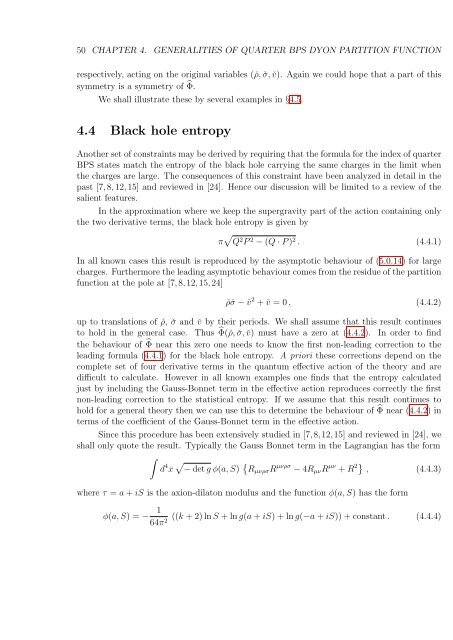PHYS08200604018 Shamik Banerjee - Homi Bhabha National ...
PHYS08200604018 Shamik Banerjee - Homi Bhabha National ...
PHYS08200604018 Shamik Banerjee - Homi Bhabha National ...
Create successful ePaper yourself
Turn your PDF publications into a flip-book with our unique Google optimized e-Paper software.
50 CHAPTER 4. GENERALITIES OF QUARTER BPS DYON PARTITION FUNCTION<br />
respectively, acting on the original variables (ˇρ, ˇσ, ˇv). Again we could hope that a part of this<br />
symmetry is a symmetry of ̂Φ.<br />
We shall illustrate these by several examples in §4.5.<br />
4.4 Black hole entropy<br />
Another set of constraints may be derived by requiring that the formula for the index of quarter<br />
BPS states match the entropy of the black hole carrying the same charges in the limit when<br />
the charges are large. The consequences of this constraint have been analyzed in detail in the<br />
past [7, 8, 12, 15] and reviewed in [24]. Hence our discussion will be limited to a review of the<br />
salient features.<br />
In the approximation where we keep the supergravity part of the action containing only<br />
the two derivative terms, the black hole entropy is given by<br />
π √ Q 2 P 2 − (Q · P ) 2 . (4.4.1)<br />
In all known cases this result is reproduced by the asymptotic behaviour of (5.0.14) for large<br />
charges. Furthermore the leading asymptotic behaviour comes from the residue of the partition<br />
function at the pole at [7, 8, 12, 15, 24]<br />
ˇρˇσ − ˇv 2 + ˇv = 0 , (4.4.2)<br />
up to translations of ˇρ, ˇσ and ˇv by their periods. We shall assume that this result continues<br />
to hold in the general case. Thus ̂Φ(ˇρ, ˇσ, ˇv) must have a zero at (4.4.2). In order to find<br />
the behaviour of ̂Φ near this zero one needs to know the first non-leading correction to the<br />
leading formula (4.4.1) for the black hole entropy. A priori these corrections depend on the<br />
complete set of four derivative terms in the quantum effective action of the theory and are<br />
difficult to calculate. However in all known examples one finds that the entropy calculated<br />
just by including the Gauss-Bonnet term in the effective action reproduces correctly the first<br />
non-leading correction to the statistical entropy. If we assume that this result continues to<br />
hold for a general theory then we can use this to determine the behaviour of ̂Φ near (4.4.2) in<br />
terms of the coefficient of the Gauss-Bonnet term in the effective action.<br />
Since this procedure has been extensively studied in [7,8,12,15] and reviewed in [24], we<br />
shall only quote the result. Typically the Gauss Bonnet term in the Lagrangian has the form<br />
∫<br />
d 4 x √ − det g φ(a, S) { R µνρσ R µνρσ − 4R µν R µν + R 2} , (4.4.3)<br />
where τ = a + iS is the axion-dilaton modulus and the function φ(a, S) has the form<br />
φ(a, S) = − 1 ((k + 2) ln S + ln g(a + iS) + ln g(−a + iS)) + constant . (4.4.4)<br />
64π2

















